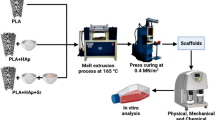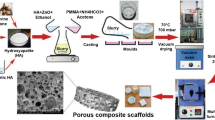Abstract
Locally derived silica and hydroxyapatite (HAp) were incorporated into polycaprolactone (PCL) polymer to produce a biocomposite material with the required properties for bone regeneration application. The silica and the hydroxyapatite were synthesized from rice husk ash and sheep bone, respectively. The effect of different concentrations of silica and HAp on the physical and mechanical properties of the PCL polymer matrix was studied. The biodegradability analysis of the scaffold was studied through weight loss in phosphate buffer saline (PBS) solution for 14 days. The porosity of the scaffold was within 39.2–54.1% close to or above the minimum required porosity of 40% while the compressive strength of the scaffold was within 9.0–12.5 MPa. Generally, the increase in silica content resulted in a reduction in porosity but it led to an increase in compressive strength through pores’ filling and crack shielding mechanism. For the hardness and fracture toughness, there was a 50% increment attributed to the increasing silica content. The Si35-HAp5 sample produced the highest hardness, fracture toughness and compressive strength but the least brittleness index. Hence, a Si35-HAp5 sample was subjected to biodegradability in an in vitro analysis. The pure PCL scaffold was faster with a 42% weight reduction compared to the 4% of Si35-HAp5 sample, while the pH remained at the neutral level. The result of this study confirms the suitability of the fabricated scaffold for bone replacement in human trabecular bone since the scaffold is endowed with enhanced mechanical properties with minimum weight loss.
Graphical abstract









Similar content being viewed by others
Data availability
Available upon request.
References
Paredes C, Martinez-Vazquez FJ, Pajares A, Miranda P (2019) Development by robocasting and mechanical characterization of hybrid HA/PCL coaxial scaffolds for biomedical applications. J Eur Ceram Soc 39:4375–4383. https://doi.org/10.1016/j.jeurceramsoc.2019.05.053
Ródenas-Rochina J, Ribelles JLG, Lebourg M (2013) Comparative study of PCL-HAp and PCL-bioglass composite scaffolds for bone tissue engineering. J Mater Sci Mater Med 24:1293–1308. https://doi.org/10.1007/s10856-013-4878-5
Kalsi S, Singh J, Sehgal SS, Sharma NK (2021) Biomaterials for tissue engineered bone Scaffolds: a review. Mater Today Proc 2021:273. https://doi.org/10.1016/j.matpr.2021.04.273
Obada DO, Osseni SA, Sina H, Salami KA, Oyedeji AN, Dodoo-Arhin D, Dauda ET (2021) Fabrication of novel kaolin-reinforced hydroxyapatite scaffolds with robust compressive strengths for bone regeneration. Appl Clay Sci 215:106298. https://doi.org/10.1016/j.clay.2021.106298
Hongquan Z, Yuhua Y, Youfa W, Shipu L (2003) Morphology and formation mechanism of hydroxyapatite whiskers from moderately acid solution. Mater Res 6:111–115. https://doi.org/10.1590/S1516-14392003000100020
Roseti L, Parisi V, Petretta M, Cavallo C, Desando G, Bartolotti I, Grigolo B (2017) Scaffolds for bone tissue engineering: state of the art and new perspectives. Mater Sci Eng C 78:1246–1262. https://doi.org/10.1016/j.msec.2017.05.017.7
Adamu MA, Sumaila M, Dauda M, Ause T (2023) Production and optimization of novel rice husk ash reinforced polycaprolactone/hydroxyapatite composite for bone regeneration using grey relational analysis. Sci Afr 19:e01563. https://doi.org/10.1016/j.sciaf.2023.e01563
Peroglio M, Gremillard L, Chevalier J, Chazeau L, Gauthier C, Hamaide T (2007) Toughening of bio-ceramics scaffolds by polymer coating. J Eur Ceram Soc 27:2679–2685. https://doi.org/10.1016/j.jeurceramsoc.2006.10.016
Chevalier J, Gremillard L (2009) Ceramics for medical applications: A picture for the next 20 years. J Eur Ceram Soc 29:1245–1255. https://doi.org/10.1016/j.jeurceramsoc.2008.08.025
Murugan S, Parcha SR (2021) Fabrication techniques involved in developing the composite scaffolds PCL/HA nanoparticles for bone tissue engineering applications. J Mater Sci Mater Med 32:1–10. https://doi.org/10.1007/s10856-021-06564-0
Pattanashetti NA, Viana T, Alves N, Mitchell GR, Kariduraganavar MY (2020) Development of novel 3D scaffolds using Bio-extruder by varying the content of hydroxyapatite and silica in PCL matrix for bone tissue engineering. J Polym Res 27:87. https://doi.org/10.1007/s10965-020-02053-0
Jinga SI, Costea CC, Zamfirescu AI, Banciu A, Banciu DD, Busuioc C (2020) Composite fiber networks based on polycaprolactone and bioactive glass-ceramics for tissue engineering applications. Polymers 12:1806. https://doi.org/10.3390/polym12081806
Babaie A, Rezaei M, Sofla RLM (2019) Investigation of the effects of polycaprolactone molecular weight and graphene content on crystallinity, mechanical properties and shape memory behavior of polyurethane/graphene nanocomposites. J Mech Behav Biomed Mater 96:53–68. https://doi.org/10.1016/j.jmbbm.2019.04.034
Baidurah S (2022) Methods of analyses for biodegradable polymers: a review. Polymers 14:4928. https://doi.org/10.3390/polym14224928
Kusakabe A, Hirota K, Mizutani T (2017) Crystallization of hydroxyapatite in phosphorylated poly(vinyl alcohol) as a synthetic route to tough mechanical hybrid materials. Mater Sci Eng C 70:487–493. https://doi.org/10.1016/j.msec.2016.09.006
Kumar J, Singh V, Pareek RK (2015) A study on the effect of fly ash and rice husk ash on strength parameters of pavement quality concrete. Int J Eng Technol 6:28
Munar ML, Udoh KI, Ishikawa K, Matsuya S, Nakagawa M (2006) Effects of sintering temperature over 1,300 C on the physical and compositional properties of porous hydroxyapatite foam. Dent Mater J 25:51–58. https://doi.org/10.4012/dmj.25.51
Ayed FB, Bouaziz J, Bouzouita K (2001) Calcination and sintering of fluorapatite under argon atmosphere. J Alloys Compd 322:238–245. https://doi.org/10.1016/S0925-8388(01)01200-2
Akpan ES, Dauda M, Kuburi LS, Obada DO, Dodoo-Arhin D (2020) A comparative study of the mechanical integrity of natural hydroxyapatite scaffolds prepared from two biogenic sources using a low compaction pressure method. Res Phys 17:103051. https://doi.org/10.1016/j.rinp.2020.103051
Obada DO, Salami KA, Alabi AA, Oyedeji AN, Csaki S, Hulan T, Meher AK (2022) Mechanical behaviour of porous kaolin-based ceramics for potential catalysts support applications. J Korean Ceram Soc 2022:1–14. https://doi.org/10.1007/s43207-022-00248-3
Verma D, Katti K, Katti D (2006) Experimental investigation of interfaces in hydroxyapatite/polyacrylic acid/polycaprolactone composites using photoacoustic FTIR spectroscopy. J Biomed Mater Res A 77:59–66. https://doi.org/10.1002/jbm.a.30592
Anbalagan G, Prabakaran AR, Gunasekaran S (2010) Spectroscopic characterization of indian standard sand. J Appl Spectrosc 77:86–94. https://doi.org/10.1007/s10812-010-9297-5
Salami KA, Obada DO, Alabi AA, Csaki S, Oyedeji AN (2022) Utilization of sawdust as a pore-former in the fabrication of ceramic adsorbents for water purification. J Aust Ceram Soc 58:1297–1309. https://doi.org/10.1007/s41779-022-00778-3
Ciarelli MJ, Goldstein SA, Kuhn JL, Cody DD, Brown MB (1991) Evaluation of orthogonal mechanical properties and density of human trabecular bone from the major metaphyseal regions with materials testing and computed tomography. J Orthop Res 9:674–682. https://doi.org/10.1002/jor.1100090507
Obada DO, Osseni SA, Sina H, Oyedeji AN, Salami KA, Okafor E, Dauda ET (2023) Hydroxyapatite materials-synthesis routes, mechanical behavior, theoretical insights, and artificial intelligence models: a review. J Aust Ceram Soc 59:1–32. https://doi.org/10.1007/s41779-023-00854-2
Fuad MY, Ismail Z, Mansor MS, Ishak ZA, Omar AK (1995) Mechanical properties of rice husk ash/polypropylene composites. Polym J 27:1002–1015. https://doi.org/10.1295/polymj.27.1002
Funding
The authors declare no funding for this study
Author information
Authors and Affiliations
Contributions
Muhammad Auwal Adamu: Conceptualization, Data curation, Formal analysis, Investigation, Methodology, Writing. Malachy Sumaila: Conceptualization, Methodology, Writing-editing, Formal analysis, Supervision. Muhammad Dauda Conceptualization, Methodology, Writing-editing, Formal analysis, Supervision. Terver Ause: Conceptualization, Methodology, Writing-editing, Formal analysis, Supervision
Corresponding author
Ethics declarations
Conflict of interest
The author declares no competing interests.
Rights and permissions
Springer Nature or its licensor (e.g. a society or other partner) holds exclusive rights to this article under a publishing agreement with the author(s) or other rightsholder(s); author self-archiving of the accepted manuscript version of this article is solely governed by the terms of such publishing agreement and applicable law.
About this article
Cite this article
Adamu, M.A., Sumaila, M., Dauda, M. et al. A novel polycaprolactone/rice husk ash/hydroxyapatite biopolymer composite for bone implant: physico-mechanical and biodegradable analysis. Iran Polym J 33, 395–404 (2024). https://doi.org/10.1007/s13726-023-01248-8
Received:
Accepted:
Published:
Issue Date:
DOI: https://doi.org/10.1007/s13726-023-01248-8




